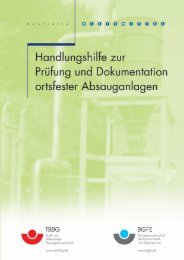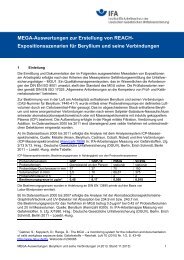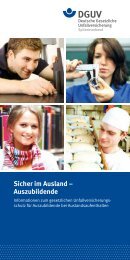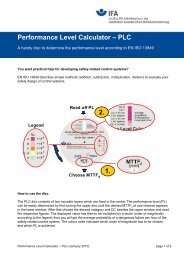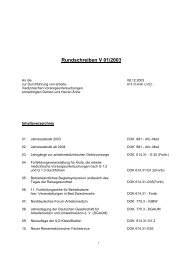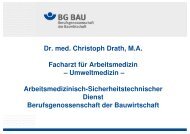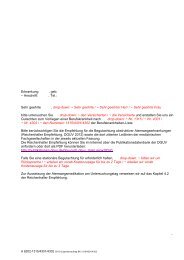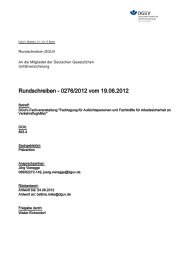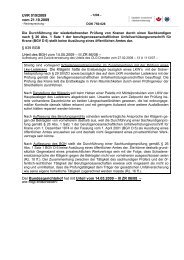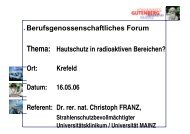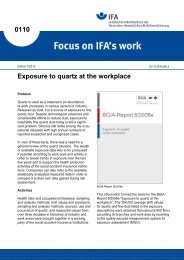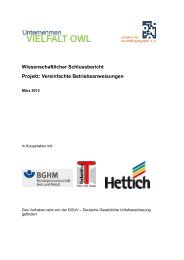Effectiveness of measures to prevent needlestick injuries among ...
Effectiveness of measures to prevent needlestick injuries among ...
Effectiveness of measures to prevent needlestick injuries among ...
You also want an ePaper? Increase the reach of your titles
YUMPU automatically turns print PDFs into web optimized ePapers that Google loves.
4 Intervention program evaluation<br />
all used gloves were tested for perforation, a surrogate measure <strong>of</strong> risk <strong>of</strong> NSI. In<br />
addition <strong>to</strong> reducing likelihood <strong>of</strong> confounding by random allocation <strong>to</strong> the blunt<br />
versus traditional needle groups, the authors evaluated potential confounding by<br />
time <strong>of</strong> day, operation length, and surgeon experience.<br />
Overall, 14 NSI were observed, all due <strong>to</strong> sharp needles. Seventy-six perforations<br />
were detected in 69 pairs <strong>of</strong> gloves, and 58 <strong>of</strong> them (76 %) were from sharp needles.<br />
Glove perforations during abdominal fascia closure were found <strong>to</strong> be mostly related<br />
<strong>to</strong> use <strong>of</strong> sharp needles (50 % due <strong>to</strong> sharp needles versus 7 % due <strong>to</strong> blunt needles;<br />
p < 0.0006). Surgeon experience and duration <strong>of</strong> procedure were not associated with<br />
the likelihood <strong>of</strong> NSI or glove perforation, but skin contamination was more likely <strong>to</strong><br />
occur during procedures carried out during the night shift.<br />
� Intermediate quality<br />
The remaining five evaluations <strong>of</strong> blunt suture needles were rated “intermediate”<br />
quality [61 <strong>to</strong> 65]. Three <strong>of</strong> these articles described evaluations <strong>of</strong> the Ethigard<br />
(Ethicon) blunt suture needle: Hartley et al. reported a decrease in the rate <strong>of</strong> glove<br />
perforation from 14/39 sharp needles used <strong>to</strong> 3/46 when the Ethigard was used,<br />
p < 0.001 [62]. Wright et al. noted 31 perforations in 16 out <strong>of</strong> 62 gloves worn while<br />
using a “cutting needle” and 18 perforations in ten out <strong>of</strong> 76 gloves worn while using<br />
a “taperpoint needle” (p = 0.049). In addition, three NSI were reported, two from<br />
cutting needles and one from a wound-drain introducer, but none from the Ethigard<br />
[64]. The final study in this group reported a reduction from 5.9 NSI/100 procedures<br />
prior <strong>to</strong> introduction <strong>of</strong> the Ethigard <strong>to</strong> 1.1 NSI/100 procedures after the Ethigard was<br />
adopted [61]. Rice et al. evaluated the Maxon Protec blunt suture needle (Davis and<br />
Geck, Inc.), and found that 16 % <strong>of</strong> outer and 6 % <strong>of</strong> inner gloves were perforated<br />
when traditional sharp needles were used, but there were no perforations <strong>among</strong><br />
gloves worn by surgeons using the Maxon Protec (p = 0.026) [63]. Meyer et al. found<br />
that 39 % <strong>of</strong> surgical gloves were perforated when standard sharp needles were used,<br />
compared <strong>to</strong> 23 % <strong>of</strong> gloves perforated with use <strong>of</strong> the Protect Point (Maxon-Faden)<br />
blunt suture needle [65].<br />
Report „Needlestick <strong>injuries</strong>“ 43



